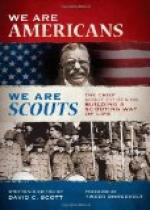As soon as Jim had corralled the train, we turned our horses over to the herders and struck out down to the river to see what condition the water was in, and to our satisfaction we found that it had just commenced to rise. Jim said, “As soon as you have eaten breakfast in the morning, Will, I wish you would ride down here and cross the river and see if the ford is clear of quick sand. If there is nothing of that kind to bother us we ought to get the whole outfit over by noon.”
When we returned to camp supper was ready. While Jim and I were eating, about a dozen ladies came to us; among them was an old lady who said, “Can’t you men coax the wolves to howl again to night?”
Jim answered, “Yes, but I will bet my old boots that before another week has passed you will want us to stop their howling so you can sleep,” to which she answered, “Well, where do they live? We don’t see or hear them in the day time.”
Jim told her that the Coyotes stayed in hollow logs or caves or in thick brush in the day time anywhere out of sight. Just at that moment a Coyote yelped; he was up the river a short distance and for the next two hours there was a continual howl. I asked the old lady if she thought the wolves needed any coaxing to make them yelp. She said, no, she guessed, Mr. Bridger was right when he said they were noisy. Early in the morning I did not wait for breakfast but mounted my horse and went down to the river. I crossed it at the ford to ascertain whether there was quick sand in the ford enough to interfere with the crossing of the emigrant train.
I will here explain to the reader that it was very necessary to examine the fords of the Platte river, as it was a treacherous stream in the way of quick sand, but this time I found nothing in the way to interfere with our crossing. When I got back to camp they were just sitting down to breakfast. I told Jim that there would be no trouble in crossing the river, to which he replied, “All right, when we get ready to cross I want you to lead the train. We will cross twenty-five wagons at a time, and I will have all the mounted men ride on each side of the wagons to keep the teams in their places.”
We were successful in landing all the wagons in safety and were all on the other side by eleven o’clock. I asked Jim where we should camp that night; he asked me how far it was to Quaking Asp Grove. I told him I thought it was about nine miles to that place.
He said, “Well, I think we can make it there in good season and that will be a good place to camp.”
I now instructed my scouts what their duty was, and we pulled out, I taking the lead from one to two and a half miles ahead of the train.
Late that afternoon I discovered considerable Indian signs where they had crossed the main trail. I followed their trail quite a way and decided that they had passed that way about two days before.




